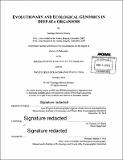| dc.contributor.advisor | Timothy M. Shank. | en_US |
| dc.contributor.author | Herrera Monroy, Santiago | en_US |
| dc.contributor.other | Woods Hole Oceanographic Institution. | en_US |
| dc.date.accessioned | 2015-06-10T19:14:55Z | |
| dc.date.available | 2015-06-10T19:14:55Z | |
| dc.date.copyright | 2015 | en_US |
| dc.date.issued | 2015 | en_US |
| dc.identifier.uri | http://hdl.handle.net/1721.1/97372 | |
| dc.description | Thesis: Ph. D., Joint Program in Oceanography/Applied Ocean Science and Engineering (Massachusetts Institute of Technology, Department of Biology; and the Woods Hole Oceanographic Institution), 2015. | en_US |
| dc.description | Cataloged from PDF version of thesis. | en_US |
| dc.description | Includes bibliographical references. | en_US |
| dc.description.abstract | Hydrothermal vents and coral ecosystems are conspicuous biological hot spots in the deep-sea. These ecosystems face increasing threats from human activities. Having thorough taxonomic inventories as well as understanding species' relatedness, genetic diversity, connectivity patterns, and adaptive potential is fundamental for the implementation of conservation strategies that help mitigate these threats. This thesis provides fundamental high-priority knowledge in taxonomic, evolutionary, and ecological aspects of deep-sea coral and vent species, by harnessing the power of genomic tools and overcoming long-standing methodological barriers. First, I develop bioinformatic tools that help guide the design of studies aiming to characterize eukaryotic genome diversity using restriction-site associated DNA sequencing. Using these tools I find that the predictability of restriction site frequencies in eukaryotic genomes is chiefly determined by the phylogenetic position of the target species and the recognition sequence of the selected restriction enzyme. These tools are then applied to test global-scale historical biogeographic hypotheses of vent fauna using barnacles as model. Phylogeographic inferences suggest that the western Pacific was the place of origin of the major vent barnacle lineage, followed by circumglobal colonization eastward along the southern hemisphere during the Neogene. I suggest that the geological processes and dispersal mechanisms discussed here can explain distribution patterns of many other marine taxa in addition to barnacles. Regional-scale analyses indicate that vent barnacle populations are well connected within basins and ridge systems, and that their diversity patterns do not conform to the predictions from the hypothesis that seamounts are centers of endemism. I then move on to resolve long-standing questions regarding species definitions in recalcitrant deep-sea coral taxa, by unambiguously resolving evolutionary relationships and objectively inferring species boundaries. Finally, I explore the adaptive potential of deep-sea coral species to environmental changes by examining a case of adaptation to shallow water from the deep sea. Candidate positive-selection markers shared between pairs of shallow and deep populations are identified as likely makers for genomic regions involved in adaptation. Overall, the results from this thesis constitute critical baseline data with which to assess potential effects of anthropogenic disturbances on deep-sea ecosystems. | en_US |
| dc.description.statementofresponsibility | by Santiago Herrera Monroy. | en_US |
| dc.format.extent | 202 pages | en_US |
| dc.language.iso | eng | en_US |
| dc.publisher | Massachusetts Institute of Technology | en_US |
| dc.rights | M.I.T. theses are protected by copyright. They may be viewed from this source for any purpose, but reproduction or distribution in any format is prohibited without written permission. See provided URL for inquiries about permission. | en_US |
| dc.rights.uri | http://dspace.mit.edu/handle/1721.1/7582 | en_US |
| dc.subject | Joint Program in Oceanography/Applied Ocean Science and Engineering. | en_US |
| dc.subject | Biology. | en_US |
| dc.subject | Woods Hole Oceanographic Institution. | en_US |
| dc.subject.lcsh | Deep-sea ecology | en_US |
| dc.subject.lcsh | Hydrothermal vents | en_US |
| dc.title | Evolutionary and ecological genomics in deep-sea organisms | en_US |
| dc.type | Thesis | en_US |
| dc.description.degree | Ph. D. | en_US |
| dc.contributor.department | Joint Program in Oceanography/Applied Ocean Science and Engineering | en_US |
| dc.contributor.department | Woods Hole Oceanographic Institution | en_US |
| dc.contributor.department | Massachusetts Institute of Technology. Department of Biology | |
| dc.identifier.oclc | 910725323 | en_US |
